Go to Birding Cruise Galápagos | Neotropical bird tours | All our birding tours
17 – 28 OCTOBER 2021
By Galo Real
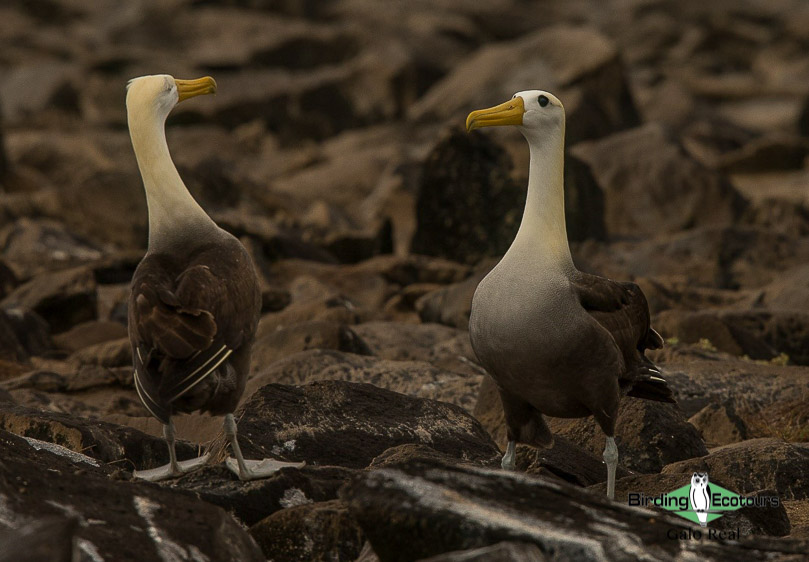
Overview
The Galápagos Islands is a dream destination for naturalists. These ever-changing islands are a living laboratory, showcasing evolution before our very eyes! Our trips here are always popular which is no surprise when you consider the birds and other wildlife we enjoy along the way, not to forget the breathtaking scenery. While cruising around the Galápagos Islands, we were based on the boat La Samba, an idyllic way to experience the beauty and majesty of the Galápagos Islands.
During this Galápagos bird tour, we particularly focused on finding the many endemics and specials of the Galápagos Archipelago. Many of the species mentioned below have evolved without the presence of land mammal predators and as such do not show much fear towards humans which means they often provide us with point-blank views. Some of the more desirable species seen included Galapagos Penguin, Waved Albatross, Galapagos Petrel, Lava Heron, Galapagos Crake, Swallow-tailed Gull, Lava Gull, Galapagos Dove, Galapagos Hawk, Floreana Mockingbird, Espanola Mockingbird, Galapagos Mockingbird, Galapagos Flycatcher, Small Ground Finch, Woodpecker Finch, Vegetarian Finch, Medium Ground Finch, Medium Tree Finch, Common Cactus Finch, Espanola Cactus Finch, and Grey Warbler-Finch.
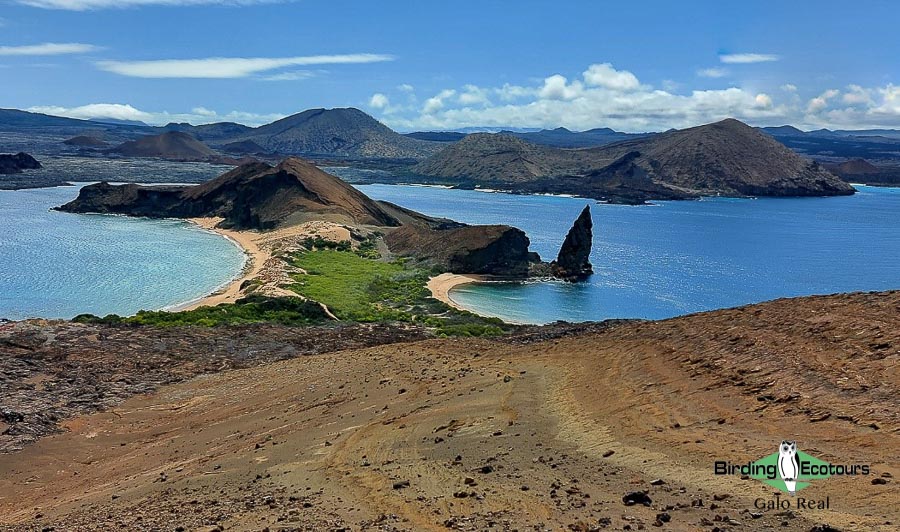
The tour also connected with some interesting and charismatic wildlife, such as Floreana Giant Tortoise, Galapagos Land Iguana, Galapagos Sea Lion, and Galapagos Fur Seal, some photos of these highly sought-after creatures are featured in this report.
The bird and animal lists for this Galápagos bird tour are included at the end of the report.
Detailed Report
Day 1. Arrival in Quito
Today, clients arrived in Quito to be in the right location to join our flight to the Galápagos Islands. For this tour we have a buffer day (Day 2) to account for late-evening Day 1 flights arriving in the Ecuadorian capital.
Day 2. Buffer Day Quito
After a great breakfast at the hotel, we drove to Quito’s Botanical Garden. The gardens represent different ecosystems of the Ecuadorian Andes and attract many resident and migratory bird species throughout the year, so it is often a surprise as to what you will see.
Right off the bat we spotted Great Thrush, Rufous-collared Sparrow, and some Band-tailed Pigeons. Once we entered the botanical garden, we were welcomed by two hummingbird species, Sparkling Violetear and Black-tailed Trainbearer. After visiting the orchid greenhouses, we saw a Black Flowerpiercer, and lots of other great birds. It was a nice relaxed-pace way to acclimatize.
We decided to go ahead and have an early lunch and go back to the hotel, to rest and prepare for the next day’s flight to the Galápagos Islands. In the evening we met up with the remaining members of the group to arrive in Quito and had a great dinner while going over the itinerary and the plans for the following day.
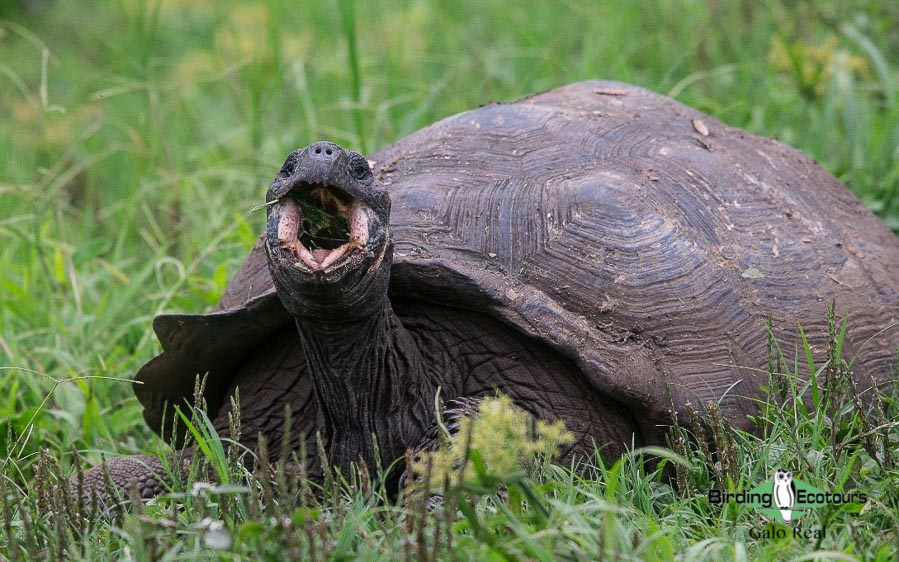
Day 3. Baltra Island and Santa Cruz Island
This morning we checked out of our hotel early so that we could be at the airport three hours before the flight, as recommended during Covid times. After presenting our vaccination cards and negative Covid test results, we boarded our flight to Baltra in the Galápagos Islands. Upon arriving in Baltra, we collected our luggage and were met by the naturalist guide and boat crew.
Right as we stepped out of the of the airport’s terminal, we saw two of the famous Darwin’s finches, Small Ground Finch and Medium Ground Finch, what a way to start our tour in the Galápagos Islands! After getting great looks of both ground finch species, we drove to El Chato, a tortoise reserve and restaurant that is home to hundreds of Floreana Giant Tortoises. We were mesmerized watching these ancient giants blissfully grazing on the lush vegetation around them. We also had our first encounter with the abundant Mangrove Warbler.
After a great lunch and a visit to the lava tubes, we made our way down to the waterfront to board our tour boat, La Samba. Blue-footed Boobies and Brown Pelicans watched on as we boarded the beautiful La Samba for our first dinner and night aboard.
Day 4. Floreana Island
After a relatively calm overnight crossing, we arrived at Punta Cormorant, which sits on the northern tip of Floreana, between two volcanic cones. The sand on one of the beaches here has a noticeably olive-green color. This is due to a much higher than usual concentration of olivine crystals in the sand. Another nearby beach is made up mainly of coral sand and is a jaw-droppingly brilliant white.
We made our way to a brackish lagoon where we all saw a large mixed group of American Flamingoes, White-cheeked Pintails, Hudsonian Whimbrels, Lava Herons, and Brown Noddies.
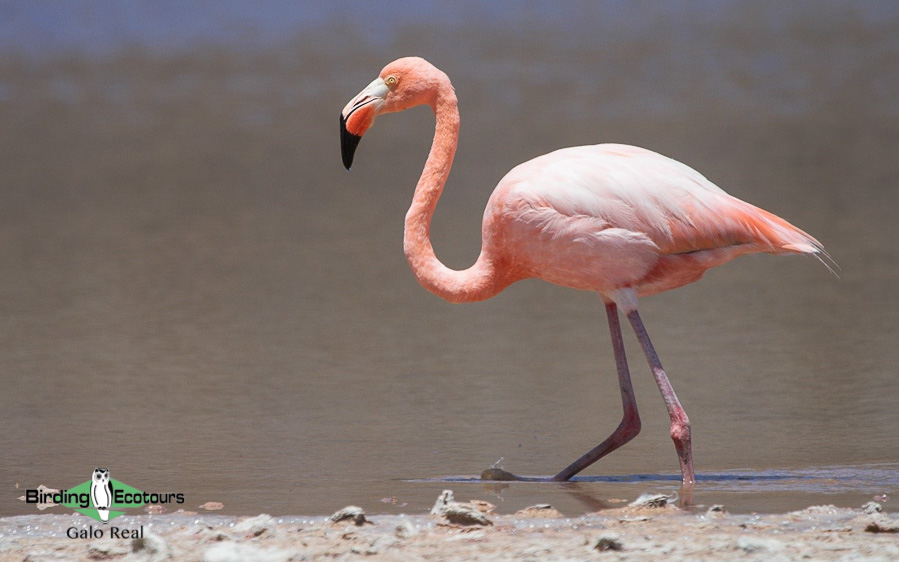
We spent much of the morning watching the flamingos and exploring the area. Along the beach edges we saw Medium Ground Finch and Small Ground Finch and we even got the chance to watch and study their different behaviors. Before going back to La Samba, we had time to walk along the beach and take some photos of Ruddy Turnstone, Yellow-crowned Night Heron, Brown Pelican, and Mangrove Warbler.
After lunch we took the zodiacs for a 25-minute journey and had the option to snorkel at Champion Islet. This small piece of land is one of two places where the rare Floreana Mockingbird thrives, as well as Medium Tree Finch, due to the lack of invasive predators such as feral cats, that still roam the main island. The mockingbirds and tree finches obliged and we also all got great looks at Common Cactus Finch, Swallow-tailed Gull, Magnificent Frigatebird, and Red-billed Tropicbird. Galapagos Sea Lions played in the waters while everyone was snorkeling. After a great afternoon we went back to La Samba for a shower and another enjoyable dinner.
Day 5. Española Island
We arrived at Punta Suarez on Española early in the morning, and I was pleased about that because it is one of those islands that, no matter where you look, there’s always something exciting happening. This particular island is one of the oldest of the Galápagos Islands. Geologists estimate that it was formed over four million years ago as a shield volcano. With the help of low-viscosity lava, Española moved away from the hotspot and became dormant.
A pair of Galapagos Hawks greeted us upon our wet landing and a horde of curious Espanola Mockingbirds scampered around our feet checking us out. Marine Iguanas and Galapagos Sea Lions were everywhere, with many being attended to by their own group of mockingbirds. We spent the morning slowly venturing down the loop trail, taking it all in. Nesting Nazca and Blue-footed Boobies, Red-billed Tropicbirds, and dozens of beautiful Swallow-tailed Gulls flew overhead, while the gorgeous Waved Albatross adults took care of their young. Most of the world’s Waved Albatross population breed on this one island and seeing them is always a tour highlight. There were some new land birds for us too, such as Espanola Cactus Finch and Grey Warbler-Finch, and we got our first decent views of the pretty Galapagos Dove.
Another famous natural feature here is the blowhole. This geological formation funnels the incoming waves into a chamber where it gets compressed and then the air and seawater are forced out at great speed, making a spectacular plume of water shoot high into the air.
In the afternoon almost everyone did a little bit of snorkeling and kayaking around Gardner Bay. The waters were warm and calm, and everyone was able to get great looks at the fascinating wildlife beneath the surface of the water.
Day 6. San Cristóbal Island
We visited Punta Pitt in the morning, this is a remote site on the far eastern tip of San Cristóbal. As we made a wet landing directly onto the beach we were welcomed by the friendly and noisy barking of the local colony of Galapagos Sea Lions! We made our way past the sea lions and followed a path that took us up to the cliffs where all three resident species of boobies nest, Blue-footed, Red-footed and Nazca Booby. Nowhere else in the Galápagos do all three species nest side-by-side like this.
While watching the very active booby nursery, we also saw a group of Magnificent Frigatebirds flying overhead and the unique Mangrove Warbler seemed to always be around. During the whole hike up to the top of Punta Pitt and back, a pair of Small Ground Finch accompanied us.
After an amazing hike, we took the zodiacs and rode out to Punta Pitt Rock, which was literally crowded with seabirds, including Wedge-rumped Storm Petrels and Swallow-tailed Gulls, and several Magnificent Frigatebirds. The weather was so nice that part of the group decided they wanted to kayak, while others decided to take the opportunity to take photographs of the area. We saw King Angelfish, Blue-throated Parrotfish, Yellowtail Surgeonfish, Cortez Rainbow Wrasse, and the amazing Moorish Idol! Pelagic birding on our way back was slow, with an almost empty sea, but in the late afternoon the amazing Galapagos Petrel suddenly showed up right next to the yacht!
In the afternoon we had the opportunity to visit Punta Lobos, a very beautiful place where a large colony of Galapagos Sea Lion occur, and we all had great views of Magnificent and Great Frigatebird, as well as Lava Gull. We took the zodiacs around the island and then hiked a great trail.
Day 7. Santa Fe and South Plaza Islands
Santa Fe is a small, flat island right in the center of the Galápagos Archipelago and is another one of the oldest volcanoes in the chain. Dating of the rocks below the water estimates that they formed around four million years ago.
In the morning we made a wet landing on the beach at Barrington Bay on the north coast of the island. There are two hiking trails, we took the loop closer to the beach that leads into a gorgeous forest of massive Opuntia cactus. This was a wonderful opportunity to see the Galapagos Land Iguana. Along the trail we also spotted Galapagos Dove, Galapagos Mockingbird, and Grey Warbler-Finch.
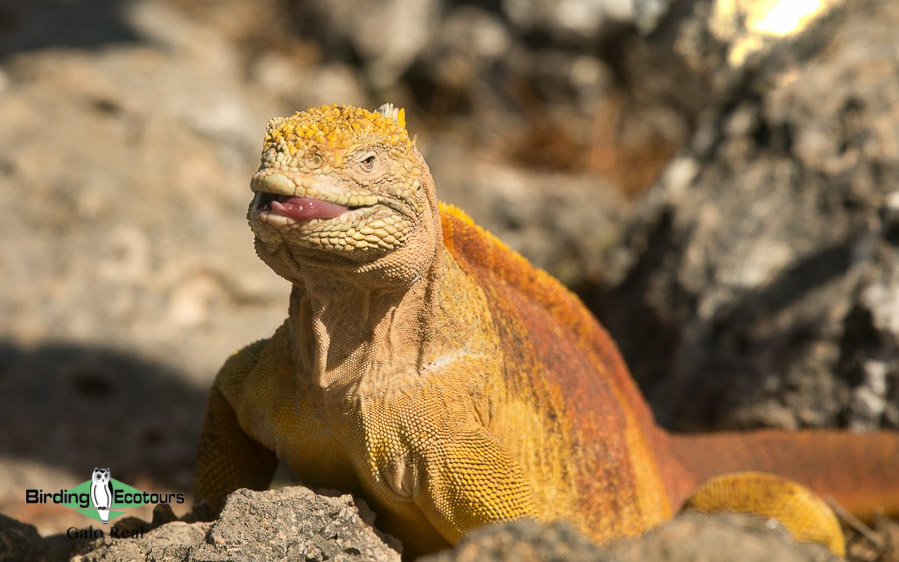
We boarded La Samba before noon to escape a momentary heavy rain shower and have another delicious lunch. In the afternoon we visited South Plaza Island. The spectacular cliffs on both the south and north coast were formed as a result of a geological uplift. Inland areas are a mix of scrubby vegetation and giant Opuntia cacti. We learned that this is the only spot on all the islands that both the marine iguanas and land iguanas breed at the same time, resulting in a hybrid form of iguana unique to the island. We took the circular hiking trail that led to the top of the cliffs here, where we had some nice views and photo opportunities of Red-billed Tropicbird, Swallow-tailed Gull, Brown Pelican, and a Lava Heron. This was yet another day full of spectacular scenery and stunning wildlife.
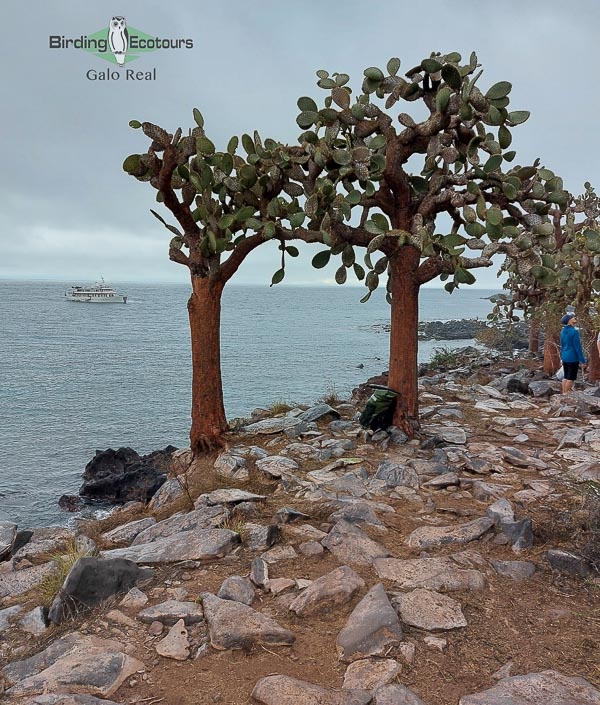
Day 8. Santiago and Bartolomé Islands
This morning we were all up early and eager to look for the Galapagos Penguin on Chinese Hat (an island named for its resemblance to a cone-shaped hat). We cruised around large volcanic peaks and shorelines and eventually spotted one penguin sitting on a rock, trying to warm up. Further along the coast, we finally spotted a small family of three penguins on the edge of the water that quickly dived into the sea to search for food. The parents and the young were “snorkeling” on top of the water, frequently looking up and then back down. Eventually, after a few minutes, they dived down and started their chase of the fish below the surface. It was an amazing experience to be so close and observe this behavior.
In the middle of the morning, we decided to take the path along the lower part of Chinese Hat and walked just over half a mile (one kilometer). Our first sighting was of two Galapagos Hawks, a mother with a juvenile. The mother barely looked at us, before taking flight and picking another perch, but the juvenile entertained us for several minutes allowing us to take some photos. On another path we saw American Oystercatchers, Lava Herons, and many Nazca Boobies.
After our hike we decided to snorkel a bit before another excellent lunch, as we navigated our way to Bartolomé Island. After an easy landing opposite Pinnacle Rock, we climbed the 375-foot (115-meter) Bartolomé Peak. When we arrived at the top of the island we were able to see Pinnacle Rock itself, the huge black lava flows of Sullivan Bay, and both the islands of Daphne Major and Daphne Minor.
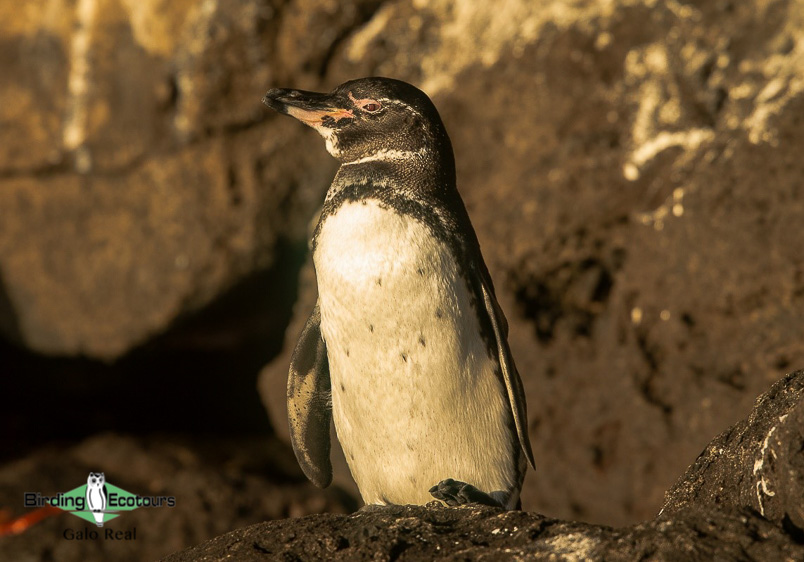
On the way back down the hill, we were able to compare two different volcanic formations evident on the island, tuff cones and volcanic spatter. Back on the beach we took advantage of the excellent snorkeling, thanks to the underwater caves and rocks in the area. We saw many different species of sharks, rays and tropical fish. Right before we were about to get out of the water a group of five Galapagos Penguins joined the fun, a truly unforgettable experience. Swimming with penguins – magical!
Day 9. Puerto Egas and Rábida
This morning we woke up in the expansive and protected James Bay (named after King James II of England). Charles Darwin wrote about his visit to James Bay when he made landfall on Santiago during his famous voyage on the HMS Beagle.
After a great breakfast we made a wet landing onto the island, at which point we all stopped and really took in the significance of where we had just landed. Lava Gull, Galapagos Flycatcher, Galapagos Mockingbird, Small Ground Finch, Mangrove Warbler, and Smooth-billed Ani seemed to be everywhere. It was a great morning, after which we went back for lunch onboard our boat.
In the afternoon we visited the red iron-rich lava beaches on La Rabida. We made a wet landing at La Espumilla on the north coast. Here, there is a nesting site for Brown Pelicans in the saltbrush behind the beach. While exploring the area we saw Galapagos Flycatcher, Galapagos Mockingbird, Common Cactus Finch, and around the lagoon, we saw White-cheeked Pintail and Galapagos Martin. Afterwards we took advantage of the calm waters and enjoyed some nice snorkeling right off the beach before heading back onboard.
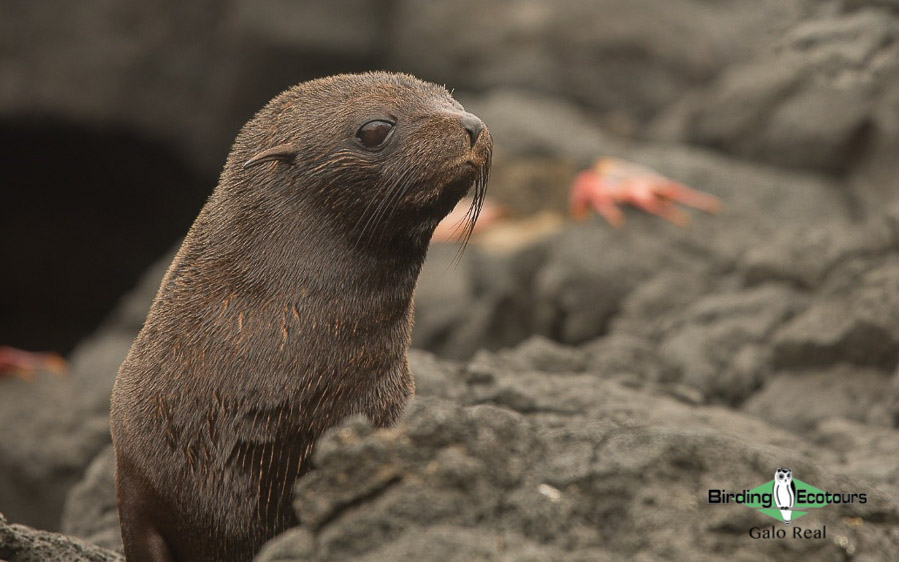
Day 10. North Seymour Island, Baltra Island
This morning we woke up off the coast of North Seymour Island. After breakfast we made a wet landing and walked a small trail around the island before heading back to La Samba to pack up before the boat arrived at the Port of Baltra, where we said our goodbyes to the boat crew. After disembarking, we met our local Galápagos guide and drove to Rancho Manzanillo for lunch. We had the opportunity to see Galapagos Crake before heading down to Puerto Ayora to visit the incredible Charles Darwin Research Station. We then went back to Casa Redonda for a quick shower before an exquisite dinner at El Muelle de Darwin.
Day 11. Santa Cruz, Airport
We left our hotel early for some last-minute highland birding to get better looks of Galapagos Crake, as we made our way back to the airport for our flight back to Quito. After an easy flight back to Quito, we said our goodbyes and reminisced about a truly great Galápagos birding and wildlife tour.
Galápagos Islands Bird List – Following IOC (12.1)
The following notation after species names is used to show conservation status following BirdLife International: CR = Critically Endangered, EN = Endangered, VU = Vulnerable, NT = Near Threatened.
| Common Name | Scientific Name |
| Ducks, Geese, Swans (Anatidae) | |
| White-cheeked Pintail | Anas bahamensis |
| Cuckoos (Cuculidae) | |
| Smooth-billed Ani | Crotophaga ani |
| Pigeons (Columbidae) | |
| Rock Dove | Columba livia |
| Galapagos Dove – NT | Zenaida galapagoensis |
| Rails, Crakes, Coots (Rallidae) | |
| Paint-billed Crake | Neocrex erythrops |
| Common Gallinule | Gallinula galeata |
| Purple Gallinule | Porphyrio martinica |
| Galapagos Crake – VU | Laterallus spilonota |
| Flamingos (Phoenicopteridae) | |
| American Flamingo | Phoenicopterus ruber |
| Oystercatchers (Haematopodidae) | |
| American Oystercatcher | Haematopus palliatus |
| Plovers (Charadriidae) | |
| Semipalmated Plover | Charadrius semipalmatus |
| Sandpipers, Snipes (Scolopacidae) | |
| Hudsonian Whimbrel | Numenius hudsonicus |
| Ruddy Turnstone | Arenaria interpres |
| Wandering Tattler | Tringa incana |
| Gulls, Terns, Skimmers (Laridae) | |
| Brown Noddy | Anous stolidus |
| Swallow-tailed Gull | Creagrus furcatus |
| Lava Gull – VU | Leucophaeus fuliginosus |
| Tropicbirds (Phaethontidae) | |
| Red-billed Tropicbird | Phaethon aethereus |
| Penguins (Spheniscidae) | |
| Galapagos Penguin – EN | Spheniscus mendiculus |
| Storm Petrel (Oceanitidae) | |
| Elliot’s Storm Petrel | Oceanites gracilis |
| Wedge-rumped Storm Petrel | Hydrobates tethys |
| Albatrosses (Diomedeidae) | |
| Waved Albatross – CR | Phoebastria irrorata |
| Petrels, Shearwaters, Diving Petrels (Procellariidae) | |
| Galapagos Petrel – CR | Pterodroma phaeopygia |
| Galapagos Shearwater | Puffinus subalaris |
| Frigatebirds (Fregatidae) | |
| Magnificent Frigatebird | Fregata magnificens |
| Great Frigatebird | Fregata minor |
| Gannets, Boobies (Sulidae) | |
| Blue-footed Booby | Sula nebouxii |
| Nazca Booby | Sula granti |
| Red-footed Booby | Sula sula |
| Herons, Bitterns (Ardeidae) | |
| Yellow-crowned Night Heron | Nyctanassa violacea |
| Lava Heron | Butorides sundevalli |
| Western Cattle Egret | Bubulcus ibis |
| Great Blue Heron | Ardea herodias |
| Pelicans (Pelicanidae) | |
| Brown Pelican | Pelecanus occidentalis |
| Kites, Hawks, Eagles (Accipitridae) | |
| Galapagos Hawk | Buteo galapagoensis |
| Barn Owls (Tytonidae) | |
| American Barn Owl | Tyto furcate |
| Flycatchers (Tyrannidae) | |
| Galapagos Flycatcher | Myiarchus magnirostris |
| Swallows, Martins (Hirundinidae) | |
| Galapagos Martin – EN | Progne modesta |
| Mockingbirds (Mimidae) | |
| Galapagos Mockingbird | Mimus parvulus |
| Floreana Mockingbird – EN | Mimus trifasciatus |
| Espanola Mockingbird – VU | Mimus macdonaldi |
| San Cristobal Mockingbird – NT | Mimus melanotis |
| New World Warblers (Parulidae) | |
| Mangrove Warbler | Setophaga petechia |
| Tanager and Allies (Thraupidae) | |
| Grey Warbler-Finch | Certhidea fusca |
| Vegetarian Finch | Platyspiza crassirostris |
| Medium Tree Finch | Camarhynchus pauper |
| Woodpecker Finch | Camarhynchus pallidus |
| Small Ground Finch | Geospiza fuliginosa |
| Espanola Cactus Finch | Geospiza conirostris |
| Large Ground Finch | Geospiza magnirostris |
| Common Cactus Finch | Geospiza scandens |
| Medium Ground Finch | Geospiza fortis |
| Total seen | 52 |
Galápagos Islands Mammal, Reptile, Fish, Crustacean, and Insect List
| Common Name | Scientific Name |
| Galapagos Sea Lion | Zalophus wollebaeki |
| Galapagos Fur Seal | Arctocephalus galapagoensis |
| Common Bottlenose Dolphin | Tursiops truncates |
| Floreana Giant Tortoise | Chelonoidis niger |
| Green Turtle | Chelonia mydas |
| Galapagos Racer | Pseudalsophis biserialis |
| Galapagos Lava Lizard | Microlophus albemarlensis |
| Hood Lava Lizard | Microlophus delanonis |
| San Cristobal Lava Lizard | Microlophus bivittatus |
| Galapagos Leaf-toed Gecko | Phyllodactylus galapagensis |
| Baur’s Leaf-toed Gecko | Dixonius aaronbaueri |
| Galapagos Land Iguana | Conolophus subcristatus |
| Barrington Land Iguana | Conolophus pallidus |
| Marine Iguana | Amblyrhynchus cristatus |
| Blue-throated Parrotfish | Notolabrus tetricus |
| Bullseye Puffer | Sphoeroides annulatus |
| King Angelfish | Holacanthus passer |
| Yellowtail Surgeonfish | Prionurus punctatus |
| Cortez Rainbow Wrasse | Thalassoma lucasanum |
| White-spotted Eagle Ray | Aetobatus narinari |
| Galapagos Shark | Carcharhinus galapagensis |
| Manta Ray | Moluba sp. |
| Mexican Hogfish | Bodianus diplotaenia |
| Moorish Idol | Zanclus cornutus |
| Whitetip Reef Shark | Triaenodon obesus |
| Sally Lightfoot Crab | Grapsus grapsus |
| Hermit Crab | Calcinus exploratory |
| Semi-terrestrial Hermit Crab | Coenobita compressus |
| Red Ghost Crab | Ocypode gaudichaudi |
| Cloudless Sulfur Butterfly | Phoebis sennae marcellina |
| Galápagos Blue Butterfly | Leptodes parrhasioides |
| Total seen | 31 |
This is a sample trip report. Please email us ([email protected]) for more trip reports from this destination.
